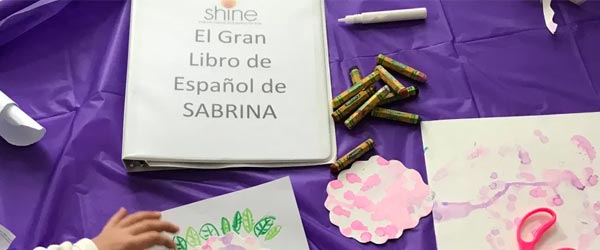Why Your Child Should Learn Spanish (And How To Make It Fun)
Surrealist filmmaker Federico Fellini once said: “A different language is a different vision of life.”
Imagine your child confidently ordering tacos al pastor in Mexico City, singing “adios rockero bebe”, or chatting with pen pals from Spain. Learning a new language is more than just a skill — it’s a gateway to richer experiences, broader perspectives, and lifelong opportunities.
The benefits go far beyond vocabulary and grammar. Research shows that bilingualism benefits include improved memory, multi-tasking, academic performance, and brain elasticity. For kids, it’s also a powerful way to connect with diverse cultures, spark curiosity, and build empathy for others.
With over 500 million speakers worldwide, Spanish is one of the easiest and most useful languages for children to learn. Whether they’re traveling, making new friends, or preparing for future career opportunities, Spanish opens doors to a world of connection, culture, and creativity.
4 Reasons Why Learning Spanish is Great for Kids
1. Spanish is one of the easiest languages for native English speakers to learn.
As a Romance language, Spanish shares a large number of cognates with English — words that have the same origin, like “correcto” (correct), “delicioso” (delicious), and “pizza” (pizza). This makes vocabulary acquisition easier. Additionally, Spanish is largely phonetic, meaning most words are pronounced the way they’re spelled, which simplifies learning pronunciation. While Spanish has different verb tenses and some grammatical exceptions, its structure aligns with English in many ways, making the grammar easier to grasp than other languages.
2. It’s easier to learn a language when they’re young.
Did you know kids are hardwired to pick up languages during their early years? Studies show that children under the age of 10 are at the peak of their ability to learn pronunciation and grammar naturally. Starting early means they’re more likely to develop native-like fluency.
3. It boosts brain development.
Learning a second language isn’t just about memorizing words; it’s a workout for the brain. Numerous studies have linked bilingualism to cognitive flexibility, better problem-solving skills and focus, improved memory and multi-tasking, and even greater creativity. Additionally, bilingualism has been shown to delay cognitive decline and protect against dementia, so think of it as mental gymnastics with lifelong cognitive benefits.
4. It builds cultural awareness.
Spanish isn’t just a language — it’s a gateway to vibrant cultures around the globe. According to researchers, bilingual people are more accepting of diverse perspectives and are better able to form friendships across cultural and social settings, adding to self-confidence and an overall sense of wellbeing. Learning Spanish helps kids appreciate diversity, whether they’re exploring Latin American music, Spanish cuisine, or the works of Pablo Picasso.
5. It sets them up for future success.
Fluency in Spanish is an incredibly marketable skill. Research from the New American Economy indicates that bilingual employees earn, on average, 5-20% more than their monolingual counterparts. Additionally, a study published in The Economist found that bilingualism improves job prospects in fields such as healthcare, business, and international relations. For students, being fluent in Spanish can make college applications stand out, as it demonstrates not only linguistic ability but also cultural competence and global awareness — qualities that are increasingly sought after in a competitive world.
When’s the Best Time to Start?
In most European countries, foreign language is compulsory for children starting at age six. Kids’ brains are like sponges, especially between the ages of two and eight, and they benefit from frequent, high-quality exposure. However, researchers have also found that 11-year-olds can catch up quickly, even with more casual forms of instruction, due to their understanding of language structure and vocabulary.
Fun Ways to Teach Your Child Spanish
Learning Spanish doesn’t have to feel like homework. Here are some creative, enjoyable ways to incorporate the language into your child’s day:
1. Sign up for a class like Shine NYC’s Listillos program.
Our Listillos class (for ages 2-12) is a dynamic, interactive way for kids to dive into Spanish. Through art, games, songs, and stories, children learn the language while exploring the cultures where it’s spoken. It’s a playful, immersive experience that brings Spanish to life.
2. Try language apps like Duolingo.
For older kids, a free and science-backed app like Duolingo makes learning Spanish feel like a game. Your child can complete fun, bite-sized lessons and earn rewards, keeping them motivated and engaged. Plus, it’s something you can do together as a family.
3. Make it part of your daily routine.
Integrate Spanish into everyday moments. Label household objects in Spanish, play Spanish songs during car rides, watch movies like “Coco” in Spanish, or say simple phrases like “buenos días” (good morning) and “por favor” (please). Consistent exposure is considered the most effective way to build fluency and comprehension of a second language over time.
4. Watch shows and read books in Spanish.
Explore kid-friendly Spanish shows like “Dora la Exploradora,” “Pocoyó,” or “La Granja de Zenón” on platforms like Netflix and YouTube. Shows with engaging songs and repetition can help children pick up phrases and vocabulary effortlessly. For storytime, try bilingual books like “La Oruga Muy Hambrienta” (The Very Hungry Caterpillar) by Eric Carle or “Abuela” by Arthur Dorros. Reading together lets kids associate words with pictures and improves comprehension while bonding over stories.
5. Play language games.
Make learning Spanish fun with interactive games. For example:
- Memory Match: Create cards with Spanish words on one side and matching pictures on the other (e.g., “gato” and a picture of a cat).
- Scavenger Hunt: Give clues like “Busca algo rojo” (Find something red) or “Encuentra un libro” (Find a book).
- Simón dice: Use phrases like “Simón dice, toca tu cabeza” (Simon says, touch your head) to practice body parts.
By incorporating games, kids stay engaged and excited about learning new words.
6. Cook a meal together.
Whip up a simple Spanish or Latin American recipe together — like quesadillas or churros — and use the opportunity for hands-on learning with a delicious twist by introducing related words like “leche” (milk) or “azúcar” (sugar) as you cook.
Staying Consistent Without Overloading
The trick to learning Spanish is keeping it consistent but stress-free. Start with small goals, like learning five new words a week or practicing a simple conversation. Celebrate progress and keep the atmosphere positive — it’s about building confidence, not perfection.
Give Your Child the Gift of Language
Teaching your child Spanish is more than just a skill — it’s a gift that opens their mind and enriches their world. Whether it’s through Shine NYC’s Listillos class, fun apps, or simple at-home activities, you’ll be giving them the tools to connect with people, cultures, and opportunities they wouldn’t otherwise have.



